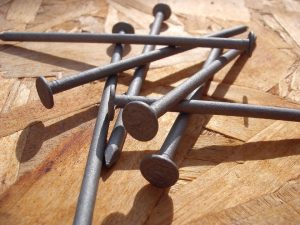
Nails are a common fastener used in construction and woodworking applications. Consisting of a long and narrow piece of solid metal with a pointed tip and flattened head, they are used to secure two or more objects together. Even if you don’t use nails on a regular basis, you’re probably familiar with this otherwise common fastener. However, you might be surprised to learn the following facts about nails.
#1) They Are Measured in ‘Pennies’
The length of nails produced and sold in the United States is measured in “pennies.” A 2d nail, for example, has a length of two pennies, whereas a 60d nail has a length of 60 pennies. With that said, you should interpret this measurement literally. A 2D nail is 1 inch longer, meaning it’s longer than two actual pennies (the currency). Penny sizes for nails originated in England where merchants would price their nails according to their length.
#2) They Originated in Ancient Egypt
To say nails are an old fastener would be an understatement. It’s unknown exactly when nails were first invented, but archeological evidence shows nails were used in Ancient Egypt around 3,400 B.C. Since then, little has changed regarding their design.
#3) They Were Originally Handmade
Nails today are manufactured using a commercial nail-making machine. The machine takes coils of wire and manipulates them into the shape of a nail. Depending on the type of machine used, it may produce as many as 500 or 700 nails per minute. In the past, however, nails were handmade by workers known as slitters and nailers. The slitters would slice up raw iron into an appropriate shape, after which they would pass the metal to a nailer.
#4) They Are Made of a Variety of Metals
For centuries, wrought iron was the primary metal in which nails were made. While you can still find wrought iron nails today, you can now find these fasteners made of other metals like aluminum, steel, copper, brass and silver. Some nails, in fact, are even made of wood.
#5) They Are Often Galvanized
To protect against corrosion, nails are often galvanized during production. There are three types of galvaniztion processes used during the production of nails: electrogalvanization, hot-dip galvanization and mechanical galvanization, all of which are designed to create a protective layer over the surface of nails.
#6) Some Have Two Heads
Not all nails have a single head. Some actually have two heads. Known as duplex nails, they allow for easier extraction with the presence of a second head that’s found slightly lower than the original head.
